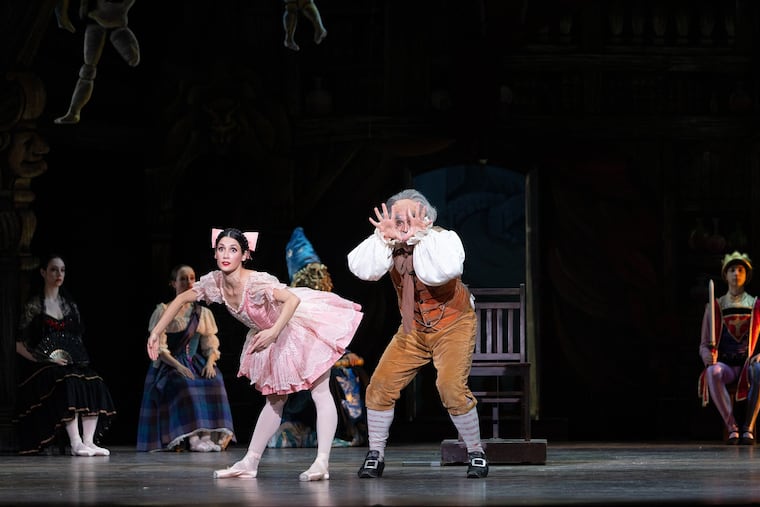Review: Philadelphia Ballet premieres Corella’s delightful new ‘Coppélia’
It is a light as air, fun, a comedic love triangle of boy, girl — and doll. Corella’s version includes mostly familiar technique, but is demands strong dancing and acting.

Philadelphia Ballet opened the final program of its season Thursday night with the world premiere of artistic director Angel Corella’s Coppélia at the Academy of Music.
It is a delightfully comedic love triangle of boy, girl and doll set to music by Léo Delibes. Corella’s version includes mostly familiar technique but demands strong dancing and acting. And the dancers came through.
Mayara Pineiro was a charming Swanilda on Thursday, delighted to introduce herself to Coppélia, the “girl” she spotted sitting with a book in a nearby window. But Coppélia, who is a doll, doesn’t wave back. Swanilda, briefly miffed, dances on. Pineiro performed light-as-air leaps and pirouettes, never breaking character.
The real trouble starts when Franz, danced by Ashton Roxander, shows more attention to the doll than to his supposed girlfriend, Swanilda. Roxander is also a good actor, portraying a young man torn between two beautiful girls. But his dancing is even stronger, especially in a variation that has him performing a series of alternating double air turns and double pirouettes. His dancing, right down to his gestures, was reminiscent of a young Corella.
Separately, Swanilda and Franz each arrange to break into the nearby studio of the eccentric Dr. Coppélius (Eddy Tovar, the director of Philadelphia Ballet II and Pineiro’s brother-in-law), which is filled with all manner of creepy dolls.
Coppélia, like The Nutcracker, is based on a story by E.T.A. Hoffmann, and there are similarities, especially in the dolls. There’s a pair of harlequin dolls, one in a Scottish costume, a doll dressed like Kitri from Don Quixote, and another that looks like Dumbledore. Pineiro borrows bits of costume from several of them and dances deftly in a variety of styles.
She also borrows Coppélia’s dress, “helping” Coppélius bring his creation to life.
Eventually, everyone realizes that Coppélia is but an inanimate object, all is forgiven, and Swanilda and Franz marry.
(Mistaken or hidden identity is another common theme in story ballets, Odette/Odile in Swan Lake, for example.)
Unlike many full-length ballets which interrupt the story with divertissements, Corella’s Coppélia front loads much of the dancing and gets into the story a bit later. The corps de ballet of friends and townspeople all have a great deal of dancing to do. They are all impressive dancers, especially in the folk dances that have dancers leap across each other or perform lifts while in formation.
Dayesi Torriente performed a precise and lovely Dawn solo, and Oksana Maslova was an ethereal Prayer, stretching through the space with little effort.
After the curtain calls, Corella stepped on stage to announce that he was promoting Roxander to principal dancer and presented him with a wreath.
Roxander, who is from Oregon, joined the second company in 2016 and quickly moved through the ranks. He studied with his parents and finished his education as a trainee at Boston Ballet under Peter Stark, who is now president and director of Philadelphia’s Rock School for Dance Education.
His brother, Jake, also danced with what is now Philadelphia Ballet II and is currently in the corps de ballet at American Ballet Theatre.
Philadelphia Ballet in “Coppélia,” 2 and 7:30 p.m. Friday and Saturday, 2 p.m. Sunday. Academy of Music, 240 S. Broad St. Tickets start at $25. 215-893-1999 or kimmelculturalcampus.org